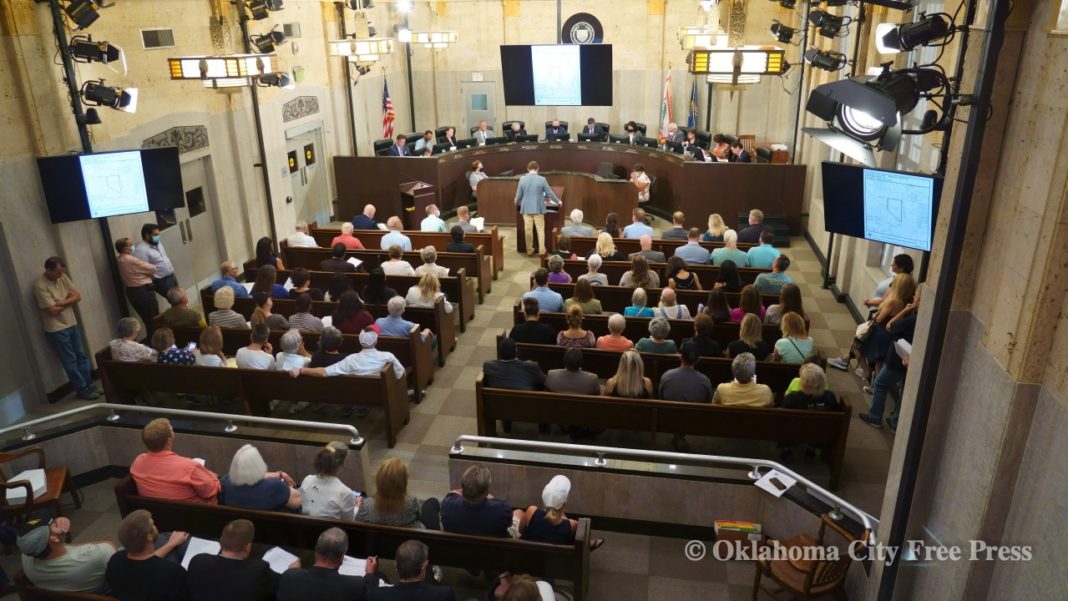Last Updated on September 28, 2021, 6:29 PM | Published: September 28, 2021
OKLAHOMA CITY (Free Press) — On Tuesday morning the City Council of Oklahoma City held their regular meeting. While Mayor David Holt was attending the National Conference of Mayors, Mayor Pro Tempore Nikki Nice (Ward 7) ably chaired the meeting.
During that meeting, the Council deferred a potentially controversial resolution regarding the oaths of office of the elected officials of the City.
Later they heard a presentation on strategies to address homelessness in Oklahoma City, the product of the Mayor’s Task Force on Homelessness.
The Council went on to renew its agreement for professional services with the Oklahoma County Criminal Justice Advisory Council (CJAC).

Marty Peercy reports Local government
Constitution Resolution
The newest members of the City Council, Bradley Carter of Ward 1 and Barbara Young of Ward 3, prepared an out-of-the-ordinary resolution for the Council. That item was to be heard at Tuesday’s Council meeting.
The resolution, found on this page, seems to be a call for loyalty over and above the oaths of office taken by each elected member of the Council.
A current requirement is that before Councilors-elect take office, they are required to swear an oath that they will uphold the United States and Oklahoma Constitutions.
Carter, Young, Nice, and Ward 4 Councilman Todd Stone took those oaths when they were sworn in this year.

Speculation from some corners suggests that the draft resolution is in response to some suggestions of vaccine mandates by OSHA for businesses employing more than 100 persons, a move which some members of the Council believe is unconstitutional.
The constitutionality of such a mandate would be a question for a higher court than the City Council of Oklahoma City, yet the freshman Councilors worked with municipal attorney Wiley Williams on drafting the resolution.
When the agenda item came up at Tuesday’s meeting, Carter asked for a deferral on the item, as Mayor Holt was not in attendance at the meeting.
A supporter of the resolution, Carol Hefner, was present and addressed the Council saying that she agreed that the Mayor should be present for a vote on the resolution.
The deferral passed 7-1 with Stone casting the lone nay vote.
That resolution should be heard again at the next Council meeting on October 12.
Homelessness Strategies
Sue Ann Arnall and Bob Ross, co-chairs of the Mayor’s Task Force on Homelessness, spoke to the Council about the process of creating strategies to address homelessness in Oklahoma City. After two years of work with a consultant firm, they were ready Tuesday to present the strategies.
Arnall and Ross welcomed Jerrod Shadid, Homeless Services Coordinator for the City, and Lindsay Cates, the new Implementation Manager for Homelessness Services. The two then presented the bundle of recommendations.
The strategies came in eight areas of focus.
The FIRST focus is on advocacy. This will include creating an updated Cost of Homelessness Study. The last time our community completed such a survey was in 2009, and many things have changed in Oklahoma City’s housing landscape since that time.
SECOND is Transition Aged Youth Services. In addition to meeting the existing problem of homelessness among young people from 16-24, this work can go a long way to preventing future homelessness.
Oklahoma City was awarded a competitive $2 million grant for youth homelessness services. This should do a great deal for expanding existing case management support as well as expanding transitional housing.
The THIRD area of focus is Transportation. The City wishes to create a new micro-transit program to more efficiently transport people to needed services around the community. They also plan to expand the bus pass program that EMBARK already has.
FOURTH is emergency and temporary shelter. The first strategy for this area is to expand coordinated entry services in shelters. This will require more agencies using the standardized diagnostic tool (VI-SPDAT and the Homeless Management Information System, a database that most local service providers use to keep case notes and service plans for clientele experiencing homelessness community-wide. This focus also includes formalizing the City’s Winter Emergency Shelter plans.
FIFTH is funding sources. Measurable outcomes are important to wealthy donors who want to see a return on their investment. Unfortunately, what are called “but for” outcomes are difficult to quantify. If a given shelter has 100 people stay overnight, we can hardly say “100 people would have died ‘but for’ the service provided by this overnight shelter.”
The City plans to develop a Housing Trust Fund that could be used to increase units of truly affordable housing in the community.
SIXTH, and perhaps most important, is affordable housing. A city cannot see its population of neighbors who are unhoused diminished without homes for those folks to move into. The City would like to create a 501c3 Land Bank.
Additionally, affordable housing can be benefitted by some zoning and ordinance changes, perhaps requiring a percentage of new development to be affordable. A lien forgiveness program has been floated. Under that program, property owners could have liens forgiven by donating their unused property back to the city to develop affordable housing stock.
The SEVENTH area of focus is prevention. Under this category, efforts can be made to help people keep from becoming homeless in the first place. This includes mortgage and rental assistance, job training, and expanding low-barrier employment opportunities. But it also includes strategies for re-entry for people leaving prisons, jail, hospitals, and other institutions. Many times people are discharged to homelessness, and that loop needs to be closed.
The EIGHTH and final focus area is outreach, engagement, and case management. While most service providers in Oklahoma City practice “Housing First,” the work doesn’t end with somebody transitioning out of homelessness. The strategies detailed under this category are largely about expanding and fine-tuning existing services so that more people can be reached and helped in their transition, then helped to learn the skills needed to maintain a home.
Ward 5 Councilman David Greenwell offered his familiar request whenever money might be spent on humanitarian efforts, “Will there be measurable outcomes?”
It was already covered during the presentation that, in fact, there would be.
Cates informed the Council that many of the strategies have already begun being implemented.
CJAC
Tim Tardibono, Executive Director of the Oklahoma County Criminal Justice Advisory Council (CJAC), gave a brief presentation to the Council about the progress of CJAC over the last year, and asked for a renewal of professional services for his group.
Readers will recall that CJAC is a county-wide panel of elected officials, law enforcement, non-profit leaders, and the fabulously wealthy. They exist as a “recommending body” that meets monthly to discuss things related to the County’s criminal legal system, especially as concerns the Oklahoma County Detention Center. The amount for the service agreement is $121,800.
Ward 6 Councilor JoBeth Hamon* asked Tardibono what measurable outcomes the City can expect for this investment.
Tardibono went over some of the improvements to the Jail since the takeover by the Oklahoma County Criminal Justice Authority (Jail Trust).
He explained to the Council that the new data tracking system used by the Jail, JailTracker, is capable of capturing far more data than ever before at the Jail.
CJAC has hired the Oklahoma Policy Institute to assist in managing and studying the data that is being collected in order to find ways to reduce the real-time population in the Jail.
In years past, the Jail – built to hold 1,200 people – has had populations of over 2,600 souls at a time. The average for the past year of the Jail Trust’s administration of the facility saw an average population of approximately 1,600. Tardibono suggested that they want that number to be far lower.
Some discussion was also had about the future of the physical facility that is the Detention Center.
Currently, CJAC has hired FSB to consult on possibilities for the Jail building. The three options they are studying are to remodel the existing building, build a new annex and retrofit some of the original building, or to build an entirely new facility. FSB will give their final presentation on their study at November’s CJAC meeting.
The Council approved the service agreement as part of the consent docket.
City Council will meet again on October 12 at 8:30 a.m.
*Hamon is the spouse of Marty Peercy, the author of this report.
Columnist covering local government in Oklahoma City and Oklahoma County from May 2019 through June 2023.










